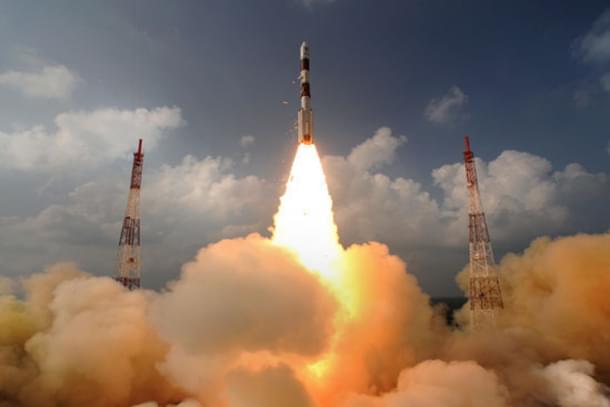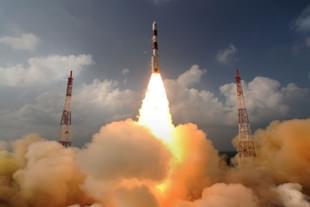Science
Racing Toward An Era Of Super Heavy Payloads To The Moon, Mars, And Beyond
Duvvuri Subrahmanyam and Pratikash Panda
Apr 25, 2023, 10:46 AM | Updated 10:46 AM IST
Save & read from anywhere!
Bookmark stories for easy access on any device or the Swarajya app.


Last week’s developmental test flight of Starship, a reusable space launch vehicle built by SpaceX, drew a lot of excited public attention, and for good reason. The 120 meters tall launch vehicle with an array of 33 engines (named Raptors) powering its first stage of flight presents an inspiringly imposing sight! In terms of thrust or propulsive force, the vehicle is twice as powerful as the Saturn V launcher which carried humans to the moon as part of NASA’s Apollo program. As a reference for scale, the Starship is almost three times taller than ISRO’s PSLV and LVM3 launchers.
The test flight was SpaceX’s first attempt at an orbital flight with the Starship. After a successful lift-off from the launch pad, the vehicle flew to an altitude of about 39 kms. At this point in flight, it appears to have executed a few cartwheel rotations due to loss of control, forcing the engineers on ground (or an automated system onboard) to hit the self-destruct button. SpaceX calls this purposeful explosion of the vehicle as “rapid unscheduled disassembly.”
For a developmental test flight, “developmental” being the key word, the show put on by Starship can be deemed successful by any reasonable measure. Since its early years, SpaceX has had an aggressive “test early, test often” approach to their launcher development programs. Every test flight, be it a “success” or otherwise, provides engineers with invaluable flight data which helps in uncovering lurking design flaws and directs them towards a robust final design. On a lighter note, an added bonus from flight testing that is public are the “failed” tests which make for spectacular viewing and great internet meme material!
Given SpaceX’s aggressive approach and its resources, it perhaps is not very far off from fixing all the technical issues with Starship and operationalizing it. Starship would then join the exclusive class of super-heavy lift launch vehicles. Entry into this class is based on the capability of a launcher to place at least 50 tonnes of payload in a low earth orbit, that is an orbit with a nominal altitude anywhere between 160 kms and 2000 kms from earth’s surface. More importantly, it would be the first super-heavy lift vehicle which is completely reusable, which makes it a game-changer in the business of Space.
When fully operational, Starship will have the ability to carry up to 150 tonnes of payload or cargo to low earth orbit in a fully reusable configuration, and up to 250 tonnes if the launcher is expended. This means capability to put next-generation large telescopes (larger than the James Webb telescope) or large robotic science missions in earth’s orbit, or to deploy multiple smaller payloads in a single launch, say several hundreds of small satellites. Further, the Starship could potentially be used as an alternative to the Space Station as it is designed to create human habitat for long-duration space missions. All this at a very competitive cost, thanks to 100% reusability of the launcher.
And nothing stops the Starship from going further from our planet — it can take several tonnes of payload, including humans, to moon, Mars, and possibly beyond. And it can bring those humans and other payloads back to Earth. One imagines that the payloads on the return trip will be resources or materials of value that are not easily available on earth (think space mining booty). If, like Elon Musk, you dream of a future with permanent human settlements on other celestial bodies with routine travel to from/to earth, then a reusable super-heavy launcher, like the Starship, is a critical piece of hardware that you need to realize those dreams.
In this context, it is worth also mentioning the Space Launch System (SLS) launcher developed recently by NASA. SLS, which also belongs to the super-heavy lift class, is the most powerful launcher built by NASA to date. SLS will be extensively used for NASA’s Artemis moon mission. However, unlike the Starship, SLS is not a reusable system, and the $2 billion per launch cost tag is a continuing concern for NASA. With that, SLS is unlikely to a see a future beyond the Artemis program.
Where does India stand and what does the future hold?
India does not yet have a super-heavy class space launcher. The most powerful launcher available today in India is ISRO’s LVM3, which can place about 8 tonnes of payload into a low earth orbit. The LVM3 core stage is powered by two Vikas engines. The Vikas is smaller than the Raptor, producing about one third of the thrust force as the Raptor. Interestingly, the Vikas thrust levels are similar to SpaceX’s Merlin engine. The first stage of SpaceX’s Falcon Heavy launcher is powered by an array of 27 Merlin engines.
Is ISRO thinking of building a super-heavy class launcher with multiple Vikas engines? No. The Vikas engines use a type of propellent (fuel and oxidizer) called hypergolic propellants, which are corrosive and toxic. This makes unsuitable for handling in very large volumes. Semi-cryogenic or cryogenic propellants are better suited for large launchers.
ISRO has been working on a semi-cryogenic engine for some years now as part of its SCE-200 development program. The engine, which would be in the same thrust class as the Raptor, uses kerosene and liquid oxygen. The organization is also drawing up plans to develop a cryogenic engine that uses liquid methane and liquid oxygen. This effort is likely to be formalized soon as a development program, parallel to the SCE-200. When either of these engine development programs taste operational success, it could form the basis for the development of heavier payload launchers, powered by an array or cluster of engines. The engines are of course only a part of the equation, albeit an important part. Several other technical challenges need to be tackled to successfully realize a reliable launcher.
In the coming years and decades, as new treaties and agreements are negotiated at the global stage for sharing of space resources beyond earth orbits, super-heavy launchers will become a ticket to the negotiation table. Technology development efforts towards heavy launchers can ensure that India can stake its claims and get its share. The challenges here also present opportunities for the private sector. Given the government’s earnest push in recent years for increasing private sector participation in space, the best-case scenario for India is effective collaboration between ISRO and private players. Incidentally, this is reflected in the recent call to India’s private industry by ISRO Chairman, S. Somanath, to come onboard as development partners and investors as ISRO conceptualizes a new reusable launcher, dubbed Next-Generation Launch Vehicle (NGLV). And maybe someday in the future, private players will take on a lead role in such efforts. India’s own SpaceX, not just in spirit and approach, but also in terms of scale.
Dr. Duvvuri Subrahmanyam (@mangaloreman on Twitter) and Dr. Pratikash Panda are Assistant Professors of Aerospace Engineering at the Indian Institute of Science (IISc) in Bengaluru. Views expressed here are personal.





